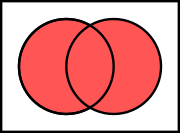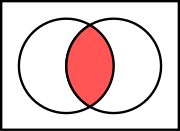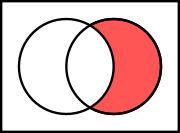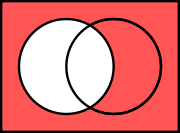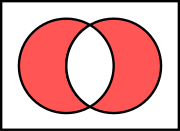Basic operations
There are several fundamental operations for constructing new sets from given sets.
Unions
Two sets can be "added" together. The union of A and B, denoted by A ∪ B, is the set of all things which are members of either A or B.
Examples:
-
- {1, 2} ∪ {red, white} = {1, 2, red, white}.
- {1, 2, green} ∪ {red, white, green} = {1, 2, red, white, green}.
- {1, 2} ∪ {1, 2} = {1, 2}.
Some basic properties of unions:
-
- A ∪ B = B ∪ A.
- A ∪ (B ∪ C) = (A ∪ B) ∪ C.
- A ⊆ (A ∪ B).
- A ∪ A = A.
- A ∪ ∅ = A.
- A ⊆ B if and only if A ∪ B = B.
Intersections
A new set can also be constructed by determining which members two sets have "in common". The intersection of A and B, denoted by A ∩ B, is the set of all things which are members of both A and B. If A ∩ B = ∅, then A and B are said to be disjoint.
Examples:
-
- {1, 2} ∩ {red, white} = ∅.
- {1, 2, green} ∩ {red, white, green} = {green}.
- {1, 2} ∩ {1, 2} = {1, 2}.
Some basic properties of intersections:
-
- A ∩ B = B ∩ A.
- A ∩ (B ∩ C) = (A ∩ B) ∩ C.
- A ∩ B ⊆ A.
- A ∩ A = A.
- A ∩ ∅ = ∅.
- A ⊆ B if and only if A ∩ B = A.
Complements
Two sets can also be "subtracted". The relative complement of B in A (also called the set-theoretic difference of A and B), denoted by A \ B, (or A − B) is the set of all elements which are members of A but not members of B. Note that it is valid to "subtract" members of a set that are not in the set, such as removing the element green from the set {1, 2, 3}; doing so has no effect.
In certain settings all sets under discussion are considered to be subsets of a given universal set U. In such cases, U \ A is called the absolute complement or simply complement of A, and is denoted by A′.
Examples:
-
- {1, 2} \ {red, white} = {1, 2}.
- {1, 2, green} \ {red, white, green} = {1, 2}.
- {1, 2} \ {1, 2} = ∅.
- {1, 2, 3, 4} \ {1, 3} = {2, 4}.
- If U is the set of integers, E is the set of even integers, and O is the set of odd integers, then E′ = O.
Some basic properties of complements:
-
- A \ B ≠ B \ A.
- A ∪ A′ = U.
- A ∩ A′ = ∅.
- (A′)′ = A.
- A \ A = ∅.
- U′ = ∅ and ∅′ = U.
- A \ B = A ∩ B′.
An extension of the complement is the symmetric difference, defined for sets A, B as
For example, the symmetric difference of {7,8,9,10} and {9,10,11,12} is the set {7,8,11,12}.
Cartesian product
A new set can be constructed by associating every element of one set with every element of another set. The Cartesian product of two sets A and B, denoted by A × B is the set of all ordered pairs (a, b) such that a is a member of A and b is a member of B.
Examples:
-
- {1, 2} × {red, white} = {(1, red), (1, white), (2, red), (2, white)}.
- {1, 2, green} × {red, white, green} = {(1, red), (1, white), (1, green), (2, red), (2, white), (2, green), (green, red), (green, white), (green, green)}.
- {1, 2} × {1, 2} = {(1, 1), (1, 2), (2, 1), (2, 2)}.
Some basic properties of cartesian products:
-
- A × ∅ = ∅.
- A × (B ∪ C) = (A × B) ∪ (A × C).
- (A ∪ B) × C = (A × C) ∪ (B × C).
Let A and B be finite sets. Then
-
- | A × B | = | B × A | = | A | × | B |.

